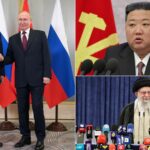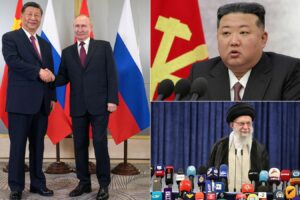Putin claims that, after the fall of the Berlin Wall, the U.S. promised not to expand NATO beyond East Germany. Does he have a case?
On January 21st, after meeting in Geneva with the Russian foreign minister, Sergei Lavrov, Secretary of State Antony Blinken issued a rather understated assessment of the high-stakes impasse between Russia and the United States, with Russia threatening the prospect of war in Ukraine. “I think the charitable interpretation would be that sometimes we and Russia have different interpretations of history,” Blinken said.
The stakes of this historical dispute could not be greater. In recent months, Russia has placed more than a hundred thousand troops, and a sizable arsenal of armor and missile systems, along its border with Ukraine. If Russia were to invade—a scenario that President Joe Biden and other Western officials have admitted is likely—the resulting violence and suffering would represent, as Biden put it, “the most consequential thing that’s happened in the world, in terms of war and peace, since World War Two.”
The particular history that the Russian President, Vladimir Putin, has in mind as he weighs starting such a conflagration is rooted in a post-Cold War settlement that he sees as having been unfairly dictated to Russia. Looming most of all is the question of nato:
Putin considers the expansion of the alliance to Eastern Europe and the Baltic states a direct threat to Russia’s security, and the idea of Ukraine drawing closer to nato—whether through the still far-off prospect of formal membership or by hosting nato troops in the meantime—an existential red line. In his mind, given that Western leaders once promised that nato would not expand toward Russia’s borders, he is merely rectifying a geopolitical injustice. At his annual press conference last December, Putin made his version of events clear: “ ‘Not one inch to the East,’ they told us in the nineties. So what? They cheated, just brazenly tricked us!”
The phrase “not one inch” is a reference to a statement made by U.S. Secretary of State James Baker, in 1990, and in the years since it has taken on the qualities of a geopolitical “Rashomon” moment. Who promised what to whom? At what cost? And who is to blame for the fact that a brief window of coöperation between the West and Russia has turned into years of mistrust and recrimination?
The many arguments, myths, and crises that have arisen from this one utterance led Mary Elise Sarotte, a historian and professor at Johns Hopkins University, to borrow it for the title of the book she published last November, “Not One Inch: America, Russia, and the Making of Post-Cold War Stalemate.” Sarotte has the receipts, as it were: her authoritative tale draws on thousands of memos, letters, briefs, and other once secret documents—including many that have never been published before—which both fill in and complicate settled narratives on both sides.
“I was trying to write a non-triumphalist history of the end of the Cold War,” Sarotte told me, the other day. That is, the opposite of the version most of us know: a tale of victory, freedom, opportunity. “And that’s in no way wrong,” she said. “Many millions of people saw their lives suddenly open up and expand.” (For an earlier book, Sarotte interviewed former East German dissidents, a number of whom had been imprisoned by the Stasi. “That’s their story entirely,” she said.)
The expansion of nato to countries once part of the Soviet-led Warsaw Pact felt like an obvious and intrinsic part of that same process, of freedom and security spreading over the continent. “But what if, from the perspective of today, the impact that same story had on someone like Putin, who saw it as a catastrophe, is no less relevant?” Sarotte asked. “There’s a non-insignificant chance we could see, in 2022, a massive European land war that is a result, at least in part, of the way Russia believes the West handled the end of the Cold War.”
In a way, the argument boils down to “not one inch” and its legacy: Did the West, led by the U.S., promise to limit nato expansion eastward? “At one extreme, there’s a position you sometimes hear from the American side, that none of this ever came up, it’s a total myth, the Russians are psychotic,” Sarotte said. “On the other end, you have the very adamant Russian position: ‘We were totally betrayed, there’s no doubt about it.’ Unsurprisingly, when you get into the evidence, the truth looks to be somewhere in between.”
Sarotte’s interpretation of the key phrase begins with the context of the moment in which it was said. In early 1990, with the Berlin Wall having fallen just months before, German unification was the central policy question in Europe. But on this matter the Soviet Union had an automatic say: as one of the officially recognized victors in the Second World War, the U.S.S.R. retained a political veto over Germany’s future, not to mention three hundred and eighty thousand troops in East Germany. Thus, West German officials—who were interested, most of all, in securing Moscow’s consent on reunification—were tempted to assuage it on the nato question. The West German foreign minister, Hans-Dietrich Genscher, gave a number of speeches proposing exactly this compromise. “An extension of NATO’s territory to the east, that is, nearer to the borders of the Soviet Union, will not happen,” he said in one address, as Sarotte recounts.
Genscher was proposing a policy position with which his own Chancellor, Helmut Kohl, would eventually come to disagree. The Chancellor ultimately believed that the West should lock in as many gains as it could before the political climate shifted yet again and Moscow’s position became more entrenched. “Foreign policy was like mowing grass for hay,” Kohl explained to the British foreign minister, Douglas Hurd, at the time. “You had to gather what you had cut in case of a thunderstorm.”
In February, 1990, Secretary Baker went to Moscow, where he met with Mikhail Gorbachev, the leader of the Soviet Union. Baker asked him—“unwittingly touching off a controversy that would last decades,” as Sarotte writes—“Would you prefer to see a unified Germany outside of NATO, independent and with no U.S. forces, or would you prefer a unified Germany to be tied to NATO, with assurances that NATO’s jurisdiction would not shift one inch eastward from its present position?” Baker was, in essence, floating his own, updated version of Genscher’s proposed trade-off, presuming that, given the wartime history, Soviet leaders would rather see Germany anchored in a multilateral alliance than left on its own.
In her book, Sarotte explains that this one sentence would take on a life of its own in the years to come: “Various leaders in Moscow would point to this exchange as an agreement barring NATO from expanding beyond its eastern Cold War border. Baker and his aides and supporters, in contrast, would point to the hypothetical phrasing and lack of any written agreement afterward as a sign that the secretary had only been test-driving one potential option of many.”
President George H. W. Bush strongly opposed Baker’s proposal, which was quickly abandoned. At a meeting at Camp David, Bush persuaded Kohl to push for a deal that allowed for a unified Germany to join nato in full, with the simple caveat that only German troops, rather than foreign ones, could be based on the territory of the former East Germany, and only after the Soviet military withdrew its own forces. In September, 1990, Gorbachev signed off on the Treaty on the Final Settlement with Respect to Germany. It looked as if the United States and Europe had managed to achieve their maximum wish list for little or no cost.
This turn of events happened for a number of overlapping reasons: crude economic necessity (Moscow, short on cash and presiding over a collapsing empire, was in desperate need of the fifteen billion Deutsche marks that it received in order to withdraw Soviet forces from East Germany); Western confidence and ambition (“To hell with that,” Bush had told Kohl at Camp David, dismissing the Soviets’ efforts to dictate Germany’s future relationship with nato. “We prevailed and they didn’t”); and bungling negotiating on the part of Gorbachev (“This carelessness will take its revenge on us,” Valentin Falin, a top Soviet official and expert on Germany, remarked).
The second moment to which Putin and his negotiators have frequently pointed is a Russia-nato agreement signed by his predecessor Boris Yeltsin in May, 1997, which paved the way for the alliance to expand to include countries in Central and Eastern Europe and the Baltics, states that successive regimes in Moscow have tended to view as under their security purview. Putin has repeatedly invoked the threat of nato military hardware “at our borders,” including in a landmark speech in 2014, on the day of the annexation of Crimea.
This history is equally messy. One night in Warsaw, over dinner and drinks, the Polish President at the time, Lech Walesa, managed to persuade Yeltsin to issue a joint statement that the prospect of Poland joining nato was “not contrary to the interest of any state, also including Russia.” But, faced with a domestic political backlash, Yeltsin quickly retracted that statement. In fact, Yeltsin and his diplomats eventually argued, the 1990 agreement on German reunification prohibited any further eastward nato expansion—if foreign troops can’t be deployed in the former East Germany, then they can’t be any further to the east, either. Putin’s current demand—clearly provocative and unrealistic—is for nato to remove its military infrastructure from states that joined after the 1997 agreement.
In the early nineties, Bill Clinton’s Administration was curious enough to look into the matter, commissioning an investigation on the question of deploying nato troops east of Germany. The takeaway was emphatic: Yeltsin was wrong. The agreement was limited to the role that nato could play in a united Germany, and had nothing to do with other countries in Eastern Europe. American diplomats should “pointedly remind the Russians of this basic fact,” the report said. Another opinion, this time from the German foreign ministry, ultimately agreed, but acknowledged that Russian claims contained a “political and psychological substance we had to take seriously.”
But the truth was that, by then, Russia’s opinion didn’t matter all that much. The West needed Moscow’s buy-in on German reunification in 1990, but there was no formal or practical reason that it needed approval on the question of extending nato membership to other countries. Washington “must be very careful not to be seen as running after the Russians, offering them concessions,” Clinton’s Secretary of State at the time, Warren Christopher, said. Moreover, Russia’s brutal war in Chechnya, launched by Yeltsin in 1994, gave additional momentum to nato enlargement. For states on Russia’s periphery, the conflict was proof that, even after the fall of the Soviet Union, Moscow could not be trusted.
The Clinton Administration settled on a policy of using “economic might in bilateral relations with Russia to achieve strategic political goals,” as Sarotte puts it. At a summit in Helsinki, Clinton promised to give Yeltsin four billion dollars in investment in 1997, as much as the U.S. had provided in the five years prior, while also dangling W.T.O. membership and other economic inducements. In return, Russia would effectively allow unencumbered nato enlargement. Yeltsin worried that these measures could be perceived as “sort of a bribe,” but, given Russia’s empty coffers and his uphill prospects for reëlection, he relented.
When Clinton learned of the fine print of the deal, which called on nato merely to avoid undefined “substantial” deployments on the territory of new member states and to organize a forum in which Russia could voice its nonbinding opinion on nato matters, he didn’t quite believe it. Sarotte quotes the scene at length:
Upon being briefed of these developments, Clinton reportedly replied, “ ‘so let me get this straight’ ”: All the Russians get out of “ ‘this great deal we’re offering them’ ” is an assurance “ ‘that we’re not going to put our military stuff into their former allies who are now going to be our allies, unless we happen to wake up one morning and decide to change our mind.’ ” Russians would get “a chance to sit in the same room with NATO” but would not have “ ‘any ability to stop us from doing something that they don’t agree with’ ” and could only “ ‘register their disapproval by walking out of the room.’ ”
The entire process of nato enlargement was, in Sarotte’s telling, marked by a “heady feeling”—it was a moment in history when, as she writes, America could flex its muscles freely. James Steinberg, who served in the State Department and on the National Security Council in the Clinton Administration, recalled, “You’re particularly attracted to things that you don’t have to do but that you want to do.”
The cumulative result was a fundamentally altered system of security in Europe, one that was especially cherished by states in Eastern Europe freed from Moscow’s yoke, and which was held up as an instrument of peace and stability by successive U.S. Presidents. And, for Russian officials from Putin on down, it’s been a stubborn, paranoid obsession. Sarotte writes, “Just as a glacier sweeps across a landscape slowly, yet alters broad swathes of terrain profoundly, so too did NATO’s expansion eastward force elements of the post-Cold War political landscape to shift and settle, leaving behind landmarks for the twenty-first century.”
The issue is that these landmarks, which look to policymakers in the West as settled and immutable, seem to Putin a debate that ought to be reopened. For a piece I wrote in December, Alexander Baunov, a senior fellow at the Carnegie Moscow Center, told me, “After so many years in power, Putin sees himself, not Gorbachev or Yeltsin, as responsible for formulating the ultimate post-Soviet order.” Baunov went on, “In this sense, many events or facts that may seem to be historically irreversible are, from his perspective, mistakes that remain to be corrected.”
Having immersed herself in the history of nato enlargement, Sarotte can imagine Putin’s vision for himself. “He looks at Gorbachev as a bad negotiator, and then what Yeltsin let happen, and thinks, I can do better than these guys,” she said.
As a result, tens of millions of Ukrainians have become the unwitting hostages in Putin’s attempt to wrest a better deal. By calling on NATO to pull military infrastructure out of Eastern Europe, and on the U.S. to offer written guarantees that it will never support Ukraine’s accession to nato, Sarotte told me, “he wants a do-over of 1997.”
There’s no way to justify Putin’s decision to hold a gun to Ukraine’s head in order to extract a better deal from the West. Still, I asked Sarotte if the current crisis could have been avoided. “I don’t want to say the West took advantage of Russia,” she said. “After all, Russia signed these agreements and knew perfectly well what it was signing.”
But, she added, Western powers would have been wise to keep in mind an aphorism of Winston Churchill’s: “In Victory: Magnanimity.” That said, as Putin now weighs invading Russia’s neighbor, with all the terrible consequences that would entail, he will likely be considering the cruel arithmetic of what he can get away with and at what cost, rather than the details of decades past. As Sarotte put it, “I don’t think Putin is all that worried about historical accuracy.”















